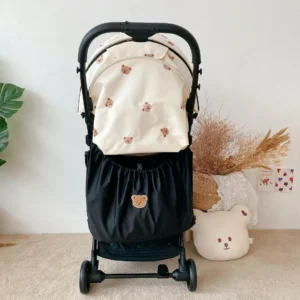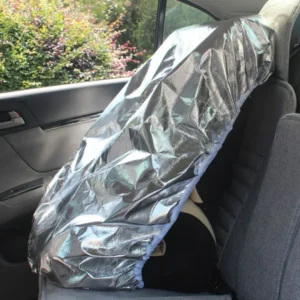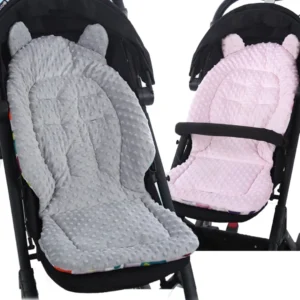Are you planning a family trip but dreading the thought of lugging around a car seat and stroller?
Don’t worry; we’ve got you covered!
In this article, we will unravel the secrets of traveling with a car seat and stroller, making your journey stress-free and ensuring your child’s safety.
Whether you’re flying with little ones or simply need to navigate busy airports, these tips and tricks will have you traveling like a pro in no time.
So sit back, relax, and get ready to discover the ins and outs of traveling with a car seat and stroller.
how to travel with a car seat and stroller
To travel with a car seat and stroller, it is recommended to check them at the ticket counter or gate.
Make sure to use protective bags to prevent damage and dirt.
When checking a car seat or stroller, remove any attached items and secure all straps.
At the gate, ask for a label for your car seat or stroller to streamline the checking process.
For protection, use a flight check stroller bag or a padded car seat bag.
Make sure the car seat is FAA-approved and fits within the airplane seat dimensions.
Install the car seat according to the manufacturer’s instructions, and remember that rear-facing infant seats should remain rear-facing on the airplane.
Check the size regulations of each airline for each flight to ensure the car seat and stroller will fit.
Ultimately, researching airline and airport regulations is crucial for a smooth traveling experience with a car seat and stroller.
Key Points:
- Check car seat and stroller at ticket counter or gate
- Use protective bags to avoid damage and dirt
- Remove attachments and secure straps before checking
- Ask for label at gate for streamlined checking process
- Use flight check stroller bag or padded car seat bag for protection
- Ensure car seat is FAA-approved and fits airplane seat dimensions
Check this out:
💡 Did You Know?
1. The car seat and stroller combo was patented by British engineer Owen Maclaren in 1965. Maclaren designed it to be lightweight and foldable, revolutionizing travel convenience for parents.
2. Did you know that car seats actually expire? Most car seat manufacturers recommend replacing car seats after six to ten years due to wear and tear. Be sure to check the expiration date on your car seat before using it.
3. The first car seat was invented in 1898 by British inventor Jean Ames. It was a simple wooden structure that aimed to prevent young children from falling off their seats while traveling in horse-drawn vehicles.
4. In some European countries, it is mandatory to have a child’s car seat in a taxi. So, if you plan to travel with your little one while abroad, make sure you’re aware of the local laws and regulations.
5. When flying with a car seat and stroller, it’s important to know that you can check them for free at the gate. Airlines are required by law to allow you to bring your child restraint system on board without any additional cost. This makes traveling with the car seat and stroller more convenient and cost-effective.
Faa-Approved Car Seats And Airplane Seat Dimensions
Flying with children can be a daunting task, especially when it comes to their safety and comfort during the flight. Car seats and strollers are essential accessories that provide both security and convenience. However, it’s crucial to remember that not all car seats and strollers are suitable for air travel. To ensure compliance with aviation regulations, car seats must be FAA-approved and fit within the specified airplane seat dimensions.
The use of child restraint systems is highly recommended by the FAA for flights. Research has shown that children who are held on a lap during flights have sustained serious and fatal injuries. On the other hand, crash tests have proven that children restrained in FAA-approved car seats have a higher chance of survival and a lower risk of serious injury in the event of an emergency. By installing a car seat on the airplane, you not only ensure your child’s safety but also create a more comfortable journey for both the parent and the child.
It’s important to consider that not all airplane seats can accommodate car seats. Car seats can only be used in seats that do not block the exit of other passengers and are not located in emergency exit rows. Additionally, car seats must fit within the width of a standard coach seat, which is typically around 16 inches. To ensure that your car seat meets these requirements, it’s crucial to check the regulations of each airline for each flight you are taking.
Checking Car Seats And Strollers – Ticket Counter Vs Gate
When traveling with a car seat and stroller, you have two options for checking them: at the ticket counter or at the gate. Both options have their pros and cons, so it’s important to consider your specific needs and circumstances when making a decision.
If you choose to check your car seat or stroller at the ticket counter, you can treat them like any other baggage. Simply remove any attached items and secure all straps before handing them over. At the ticket counter or curbside, you can check your items, making it convenient if you have other luggage that needs to be checked as well.
On the other hand, if you prefer to keep your car seat and stroller with you until you reach the gate, you can do so. At the gate, the flight attendant or gate staff will provide a label for your car seat or stroller. To streamline the checking process, it’s advised to ask for the label as soon as you arrive at the gate. This option allows you to continue using your car seat and stroller until the last minute, ensuring your child’s comfort and convenience.
The Importance Of Using Child Restraint Systems On Flights
Child restraint systems, such as car seats, are crucial for the safety and well-being of children during flights. The American Society of Pediatrics recommends the use of child restraint systems during air travel, and the FAA also supports this recommendation. Children held on a lap during flights have sustained serious and fatal injuries that could have been prevented with the use of proper restraints.
If you’re hesitant about using a car seat on the airplane, it’s important to understand the benefits it provides. Crash tests have demonstrated that children restrained in FAA-approved car seats have a better chance of survival and avoiding serious injury in the event of an emergency. Additionally, using a car seat provides reassurance for both the parent and the child, making the journey more comfortable and enjoyable.
Leaving car seats and strollers at home and renting equipment at the destination may not meet safety standards or maintenance requirements. It’s crucial to prioritize your child’s safety and convenience by bringing your own FAA-approved car seat and stroller.
- Child restraint systems are essential for child safety during flights.
- The American Society of Pediatrics recommends using child restraint systems.
- The FAA supports the use of child restraint systems.
- Children held on a lap during flights have experienced serious and fatal injuries.
- Crash tests have shown that FAA-approved car seats improve the chances of survival and reduce serious injuries during emergencies.
- Using a car seat provides comfort and reassurance for both the parent and the child.
- Renting equipment at the destination may not meet safety standards, so bringing your own FAA-approved car seat and stroller is important.
Recommended Stroller And Car Seat Options For Traveling
Choosing the right stroller and car seat for air travel is essential to ensure convenience and ease of use. When it comes to strollers, it’s recommended to purchase a smaller and lightweight option specifically designed for traveling. Travel systems, which include both a stroller and a car seat, can be cumbersome and difficult to fold and unfold, making them less suitable for air travel.
One highly recommended stroller for traveling is the Mountain Buggy Nano Duo Stroller. This stroller is infant car seat ready and can easily fit in the overhead locker of most flights. Its compact size and lightweight design make it perfect for air travel, while still providing comfort and convenience for both the parent and the child.
As for car seats, the Chico KeyFit 30 is preferred for its relatively lightweight and easy-to-install features. This car seat meets FAA regulations and ensures the safety of your child throughout the flight. It’s important to select a car seat that fits within the specified airplane seat dimensions to ensure compliance with aviation regulations.
Protecting Strollers And Car Seats During Air Travel
When traveling, it is important to protect strollers and car seats from damage and dirt. While they can be checked like any other baggage, using protective bags adds an extra layer of protection.
For strollers, a flight check stroller bag is recommended to keep it clean during the flight. It is important to note that these bags do not prevent structural damage, but they focus on keeping the stroller clean in the baggage hold. The Alnoor USA Flight Check Bag is a recommended option for protecting your stroller during air travel.
Similarly, car seats can be protected with a JL Childress Check Bag. This bag helps keep the car seat clean throughout the journey, but it does not provide structural damage protection. For enhanced protection, the JL Childress Padded Car Seat Bag offers a padded cocoon and comfortable carrying straps. With this bag, you can ensure that your car seat remains safe and secure during the flight.
Understanding Airline And Airport Regulations For Car Seats And Strollers
To have a smooth and hassle-free traveling experience with your car seat and stroller, it’s crucial to familiarize yourself with airline and airport regulations.
Each airline may have specific rules and requirements regarding the size dimensions of car seats and strollers, as well as their handling procedures during check-in and boarding.
By researching the regulations beforehand, you can ensure that your car seat or stroller complies with the airline’s guidelines and avoid any last-minute surprises or inconveniences. Additionally, understanding how strollers and car seats will be handled at your destination is essential. Having a backup plan in case of damage or loss can provide peace of mind.
In conclusion, traveling with a car seat and stroller can be stressful, but it’s essential for the safety and comfort of children during flights. By choosing FAA-approved car seats and fitting within aircraft seat dimensions, checking them at the ticket counter or gate, and using protective bags, you can ensure a smooth and convenient travel experience.
- Research airline and airport regulations beforehand
- Ensure your car seat or stroller complies with guidelines
- Understand how they will be handled at your destination
- Have a backup plan for damage or loss
Prioritizing your child’s safety and adhering to airline and airport regulations will help make your journey with a car seat and stroller a breeze.
FAQ
Can you take a stroller and car seat on a plane?
Yes, passengers are allowed to bring strollers and car seats on a plane. Airlines typically offer the option to check these items for free at the gate or ticket counter. This policy ensures that parents and guardians can easily transport their children’s essential equipment. There is no strict limit on the number of assistive devices allowed, as long as it is within reason, allowing passengers to have peace of mind when flying with their little ones.
How do you get through TSA with a stroller and car seat?
When traveling with a stroller and car seat, it’s important to follow the TSA guidelines to ensure a smooth screening process. As you approach the security checkpoint, you should collapse the stroller and remove any items from the pockets or baskets. Place these items, along with the car seat, on the X-ray belt for screening. This will help expedite the process and allow the TSA agents to thoroughly inspect your stroller and car seat without any obstructions. Remember to also place all other carry-on baggage, such as children’s toys and bags, on the X-ray belt for screening. By adhering to these guidelines, you can easily navigate through TSA with your stroller and car seat.
How do you travel with a baby car seat?
When traveling with a baby car seat, you have the convenience of being able to check it for free, along with other essential baby items like a stroller or portable crib. Depending on your preference, you can either check the car seat at the ticket counter or bring it with you to the gate. This flexibility allows parents to ensure the safety and comfort of their child during air travel, without the additional hassle or cost of transporting the car seat separately.
How do I check a car seat at the airport?
To check a car seat at the airport, simply inform the ticketing agent upon reaching the front. Kindly mention that you need to check a car seat as a baby item, and they will be happy to assist you. The agent will then provide you with a tag to ensure it is included with your checked luggage, and the best part is, there is no additional fee for this service.




